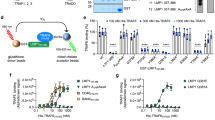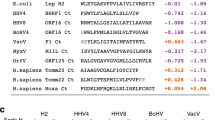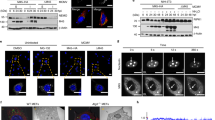Abstract
Epstein–Barr virus (EBV) is a herpes virus that is associated with several human cancers. Infection of B cells by EBV leads to their induction and maintenance of proliferation and requires the oncogene, latent membrane protein 1 (LMP1). LMP1 signals in a ligand-independent manner and is expressed at widely different levels in cells of a single clone. It is this unusual distribution that allows LMP1 to stimulate multiple, distinct pathways. Average levels of LMP1 induce proliferation while high levels induce cytostasis and inhibition of protein synthesis. These inhibitory pathways are induced by the six transmembrane domains of LMP1. We uncovered a novel function encoded by transmembrane domains 3–6 of LMP1; they induce autophagy in a dose-dependent manner and thus, modify the physiology of their host. Cells that express low levels of LMP1 display early stages of autophagy, autophagosomes; those that express high levels of this oncogene display late stages of autophagy, autolysosomes. Inhibition of autophagy in EBV-positive cells leads to an accumulation of LMP1 and a decreased ability to form colonies. These results indicate that LMP1's induction of autophagy contributes to its own regulation and that of its host cell.
This is a preview of subscription content, access via your institution
Access options
Subscribe to this journal
Receive 50 print issues and online access
$259.00 per year
only $5.18 per issue
Buy this article
- Purchase on Springer Link
- Instant access to full article PDF
Prices may be subject to local taxes which are calculated during checkout





Similar content being viewed by others
References
Baehrecke EH . (2005). Autophagy: dual roles in life and death? Nat Rev Mol Cell Biol 6: 505–510.
Baichwal VR, Sugden B . (1987). Posttranslational processing of an Epstein–Barr virus-encoded membrane protein expressed in cells transformed by Epstein–Barr virus. J Virol 61: 866–875.
Bornkamm GW, Hammerschmidt W . (2001). Molecular virology of Epstein–Barr virus. Philos Trans R Soc Lond B Biol Sci 356: 437–459.
Delecluse HJ, Hilsendegen T, Pich D, Zeidler R, Hammerschmidt W . (1998). Propagation and recovery of intact, infectious Epstein–Barr virus from prokaryotic to human cells. Proc Natl Acad Sci USA 95: 8245–8250.
Devergne O, Hatzivassiliou E, Izumi KM, Kaye KM, Kleijnen MF, Kieff E et al. (1996). Association of TRAF1, TRAF2, and TRAF3 with an Epstein–Barr virus LMP1 domain important for B-lymphocyte transformation: role in NF-kappaB activation. Mol Cell Biol 16: 7098–7108.
Dirmeier U, Hoffmann R, Kilger E, Schultheiss U, Briseno C, Gires O et al. (2005). Latent membrane protein 1 of Epstein–Barr virus coordinately regulates proliferation with control of apoptosis. Oncogene 24: 1711–1717.
Dirmeier U, Neuhierl B, Kilger E, Reisbach G, Sandberg ML, Hammerschmidt W . (2003). Latent membrane protein 1 is critical for efficient growth transformation of human B cells by Epstein–Barr virus. Cancer Res 63: 2982–2989.
Gires O, Kohlhuber F, Kilger E, Baumann M, Kieser A, Kaiser C et al. (1999). Latent membrane protein 1 of Epstein–Barr virus interacts with JAK3 and activates STAT proteins. EMBO J 18: 3064–3073.
Gires O, Zimber-Strobl U, Gonnella R, Ueffing M, Marschall G, Zeidler R et al. (1997). Latent membrane protein 1 of Epstein–Barr virus mimics a constitutively active receptor molecule. EMBO J 16: 6131–6140.
Gregory CD, Rowe M, Rickinson AB . (1990). Different Epstein–Barr virus-B cell interactions in phenotypically distinct clones of a Burkitt's lymphoma cell line. J Gen Virol 71 (Part 7): 1481–1495.
Humme S, Reisbach G, Feederle R, Delecluse HJ, Bousset K, Hammerschmidt W et al. (2003). The EBV nuclear antigen 1 (EBNA1) enhances B cell immortalization several thousandfold. Proc Natl Acad Sci USA 100: 10989–10994.
Ichimura Y, Kirisako T, Takao T, Satomi Y, Shimonishi Y, Ishihara N et al. (2000). A ubiquitin-like system mediates protein lipidation. Nature 408: 488–492.
Kabeya Y, Mizushima N, Ueno T, Yamamoto A, Kirisako T, Noda T et al. (2000). LC3, a mammalian homologue of yeast Apg8p, is localized in autophagosome membranes after processing. EMBO J 19: 5720–5728.
Kavathas P, Bach FH, DeMars R . (1980). Gamma ray-induced loss of expression of HLA and glyoxalase I alleles in lymphoblastoid cells. Proc Natl Acad Sci USA 77: 4251–4255.
Kaye KM, Izumi KM, Kieff E . (1993). Epstein–Barr virus latent membrane protein 1 is essential for B-lymphocyte growth transformation. Proc Natl Acad Sci USA 90: 9150–9154.
Kaykas A, Sugden B . (2000). The amino-terminus and membrane-spanning domains of LMP-1 inhibit cell proliferation. Oncogene 19: 1400–1410.
Kaykas A, Worringer K, Sugden B . (2002). LMP-1's transmembrane domains encode multiple functions required for LMP-1's efficient signaling. J Virol 76: 11551–11560.
Kieser A, Kilger E, Gires O, Ueffing M, Kolch W, Hammerschmidt W . (1997). Epstein–Barr virus latent membrane protein-1 triggers AP-1 activity via the c-Jun N-terminal kinase cascade. EMBO J 16: 6478–6485.
Kilger E, Kieser A, Baumann M, Hammerschmidt W . (1998). Epstein–Barr virus-mediated B-cell proliferation is dependent upon latent membrane protein 1, which simulates an activated CD40 receptor. EMBO J 17: 1700–1709.
Knutson JC, Yee D . (1987). Electroporation: parameters affecting transfer of DNA into mammalian cells. Anal Biochem 164: 44–52.
Komatsu M, Waguri S, Chiba T, Murata S, Iwata J, Tanida I et al. (2006). Loss of autophagy in the central nervous system causes neurodegeneration in mice. Nature 441: 880–884.
Lam N, Sandberg ML, Sugden B . (2004). High physiological levels of LMP1 result in phosphorylation of eIF2 alpha in Epstein–Barr virus-infected cells. J Virol 78: 1657–1664.
Lam N, Sugden B . (2003). CD40 and its viral mimic, LMP1: similar means to different ends. Cell Signal 15: 9–16.
Lee J, Sugden B . (2007). A membrane leucine heptad contributes to LMP1's trafficking, signaling and transformation. J Virol 81: 9121–9130.
Martin J, Sugden B . (1991). Transformation by the oncogenic latent membrane protein correlates with its rapid turnover, membrane localization, and cytoskeletal association. J Virol 65: 3246–3258.
Mizushima N, Noda T, Yoshimori T, Tanaka Y, Ishii T, George MD et al. (1998). A protein conjugation system essential for autophagy. Nature 395: 395–398.
Mosialos G, Birkenbach M, Yalamanchili R, VanArsdale T, Ware C, Kieff E . (1995). The Epstein–Barr virus transforming protein LMP1 engages signaling proteins for the tumor necrosis factor receptor family. Cell 80: 389–399.
Neuhierl B, Feederle R, Hammerschmidt W, Delecluse HJ . (2002). Glycoprotein gp110 of Epstein–Barr virus determines viral tropism and efficiency of infection. Proc Natl Acad Sci USA 99: 15036–15041.
Paludan C, Schmid D, Landthaler M, Vockerodt M, Kube D, Tuschl T et al. (2005). Endogenous MHC class II processing of a viral nuclear antigen after autophagy. Science 307: 593–596.
Ravikumar B, Duden R, Rubinsztein DC . (2002). Aggregate-prone proteins with polyglutamine and polyalanine expansions are degraded by autophagy. Hum Mol Genet 11: 1107–1117.
Sandberg M, Hammerschmidt W, Sugden B . (1997). Characterization of LMP-1's association with TRAF1, TRAF2, and TRAF3. J Virol 71: 4649–4656.
Tanida I, Ueno T, Kominami E . (2004). Human light chain 3/MAP1LC3B is cleaved at its carboxyl-terminal Met121 to expose Gly120 for lipidation and targeting to autophagosomal membranes. J Biol Chem 279: 47704–47710.
Tassa A, Roux MP, Attaix D, Bechet DM . (2003). Class III phosphoinositide 3-kinase—Beclin1 complex mediates the amino acid-dependent regulation of autophagy in C2C12 myotubes. Biochem J 376: 577–586.
Taylor GS, Long HM, Haigh TA, Larsen M, Brooks J, Rickinson AB . (2006). A role for intercellular antigen transfer in the recognition of EBV-transformed B cell lines by EBV nuclear antigen-specific CD4+ T cells. J Immunol 177: 3746–3756.
Uchida J, Yasui T, Takaoka-Shichijo Y, Muraoka M, Kulwichit W, Raab-Traub N et al. (1999). Mimicry of CD40 signals by Epstein–Barr virus LMP1 in B lymphocyte responses. Science 286: 300–303.
Yoshimori T . (2004). Autophagy: a regulated bulk degradation process inside cells. Biochem Biophys Res Commun 313: 453–458.
Acknowledgements
We thank Dr Takashi Ueno for kindly providing the antibody against LC3. We also thank Dr Marisa Otegui and Dr Tomomi Nakahara for valuable discussions. We are grateful to the Flow Cytometry Facility of the UW Paul P Carbone Comprehensive Cancer Center and the UW-Electron Microscope Facility. This work was supported by NIH grants CA070723 and P30 CA014520. Bill Sugden is an American Cancer Society Research Professor.
Author information
Authors and Affiliations
Corresponding author
Rights and permissions
About this article
Cite this article
Lee, D., Sugden, B. The latent membrane protein 1 oncogene modifies B-cell physiology by regulating autophagy. Oncogene 27, 2833–2842 (2008). https://doi.org/10.1038/sj.onc.1210946
Received:
Revised:
Accepted:
Published:
Issue Date:
DOI: https://doi.org/10.1038/sj.onc.1210946
Keywords
This article is cited by
-
Lymph node targeted multi-epitope subunit vaccine promotes effective immunity to EBV in HLA-expressing mice
Nature Communications (2023)
-
EBV-LMP1 promotes radioresistance by inducing protective autophagy through BNIP3 in nasopharyngeal carcinoma
Cell Death & Disease (2021)
-
Novel EBV LMP1 C-terminal domain binding affibody molecules as potential agents for in vivo molecular imaging diagnosis of nasopharyngeal carcinoma
Applied Microbiology and Biotechnology (2021)
-
Suppression of lytic replication of Kaposi’s sarcoma-associated herpesvirus by autophagy during initial infection in NIH 3T3 fibroblasts
Archives of Virology (2016)
-
HIV infection and antiretroviral therapy lead to unfolded protein response activation
Virology Journal (2015)



